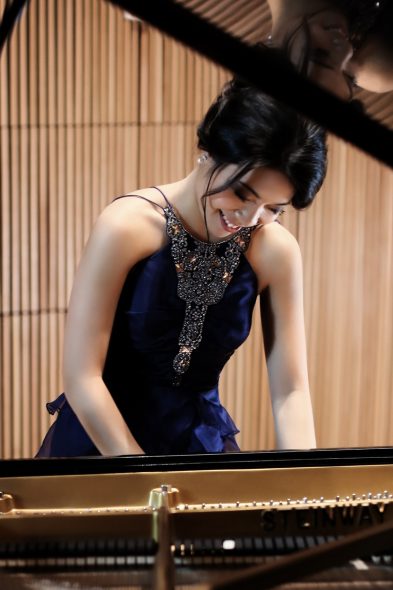MSO Plays Bernstein’s Autobiographical Work
His second symphony paired with Brahms first, two very different but potent works.
Picture Edward Hopper’s painting Nighthawks. It’s late at night sometime in 1947 and four strangers sit in a bar in Manhattan. “Estranged, aloof, they brood over being till the bars close.” This is the world of W. H. Auden’s long narrative poem The Age of Anxiety, which inspired Leonard Bernstein to compose his Second Symphony.
This weekend, the Milwaukee Symphony Orchestra will perform Bernstein’s Symphony No. 2 on a program that also features Johannes Brahms’ Symphony No. 1 in C Minor. Michael Francis, Music Director of the Florida Orchestra, will conduct. Joyce Yang is featured as piano soloist for the Bernstein symphony.
Auden’s Age of Anxiety is subtitled “A Baroque Eclogue,” a dramatic poem about society and politics, and Bernstein was clearly attracted to its astringent bleakness. As one of the characters says, “you will soon . . . acknowledge yourself as market-made, a commodity.” Convinced that the audience needed to know the poem, Bernstein wrote an extensive series of program notes for the premiere performance with the Boston Symphony Orchestra. “When I first read the book I was breathless,” said Bernstein. Through Auden’s words, Bernstein found a statement about “our difficult and problematical search for faith.”
The Second Symphony is a hybrid of tone poem and piano concerto. Bernstein referred to the piano as “an autobiographical protagonist.” Following the structure of the poem, the 40-minute symphony is in two parts of three sections each, rather than the standard four movements of a symphony.
YouTube: Leonard Bernstein: Symphony No.2 “The Age of Anxiety,” Israel Philharmonic Orchestra, Lukas Foss, piano solo.
Auden based the structure of Part One of Shakespeare’s Seven Ages of Man, a monologue from the play As You Like It. Of the four protagonists in the Auden poem, each speaker has “their entrances and their exits.” Bernstein follows Auden’s structure in his symphony. A prologue leads into a piano solo that introduces Seven Ages composed of seven variations.
Part Two of the symphony opens with “The Dirge,” a twelve-tone row that establishes the main theme. Sharing a cab, the four characters lament the loss of the “colossal father,” “didactic digit and dreaded voice, Which imposed peace on the pullulating, Primordial mess.” This curious section is followed by “The Masque,” a jazzy party scene for piano solo and percussion. The epilogue is optimistic, a statement of faith announced by a trumpet solo that develops into a broad harmonic progression that evokes the works of Aaron Copland and Virgil Thompson.
The evening’s program continues with Brahms’ Symphony No. 1, which the composer once said he would never write. Brahms feared he couldn’t live up to the legacy of Ludwig van Beethoven, once confessing, “You have no idea how the likes of us feel, when we feel the tramp of a giant like him behind us.” Brahms began his First Symphony in the 1850s and completed it more than 20 years later, in 1876.
It has been called “Beethoven’s Tenth,” suggesting Brahms was the first worthy successor (a half century later!) to the symphonic master. An early program from 1902 noted that the symphony represents “a fierce struggle and a glorious victory,” a struggle “in which human nature grapples with overshadowing fate” and eventually ascends “from darkness to light.”
The symphony opens on a grand scale, with chromatic themes underscored by ominous timpani. The second and third movements are modest and pastoral, leading into a final movement marked by the appearance of the Alphorn.
The inimitable critic Donald Francis Tovey called the symphony a work of “immense tragedy,” and frequently characterizes the movements in terms of “clouds” that part to reveal rays of hope and triumph. When the symphony was performed in Leipzig, the audience was divided, reportedly undecided “whether the finale led to heaven or hell.”
“Brahms and Bernstein” will be performed at 8 p.m. Friday, November 17 and Saturday, November 18. Tickets are available from the Marcus Center for the Performing Arts by calling 414-273-7206. Tickets range from $27 to $107. Student Rush tickets are available for $12.00 beginning two hours before all regular season Classics or Pops concerts. Seniors 65 or older can purchase MSO tickets at 50 percent off regular prices in person and on the day of the concert.
Preview
-
A Sacred Choir, 70 Voices Strong
 Dec 14th, 2025 by Martha Brown
Dec 14th, 2025 by Martha Brown
-
Prometheus Trio Goes Bohemian
 Dec 3rd, 2025 by Martha Brown
Dec 3rd, 2025 by Martha Brown
-
Present Music Offers New Choral Works
 Nov 20th, 2025 by Michael Barndt
Nov 20th, 2025 by Michael Barndt























I have tickets, and can’t wait to hear this show!